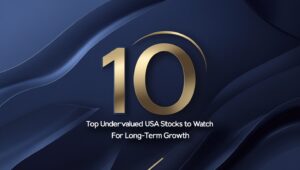Who doesn’t love the idea of making money while doing absolutely nothing? That’s the dream, right? Passive income is like having a magic money tree in your backyard, and one of the best ways to grow that tree is by investing in high-dividend stocks. But here’s the thing: not all dividend stocks are created equal. If you’re looking to build a steady stream of passive income by 2025, you’ve got to know how to pick the right ones. Don’t worry, though—I’m here to break it down for you in a way that’s easy to understand, even if you’re not a Wall Street pro.
What Are Dividend Stocks?
Before we dive into the nitty-gritty, let’s make sure we’re on the same page. Dividend stocks are shares of companies that pay out a portion of their profits to shareholders on a regular basis. Think of it like getting a slice of the company’s pie just for owning a piece of it. These payments are called dividends, and they’re usually distributed quarterly (every three months).
Some companies are known for paying high dividends consistently, and these are the ones we’re after. Why? Because they can provide a reliable source of income, especially if you’re planning for the long term. And let’s be real—who wouldn’t want a little extra cash rolling in every few months?
Why High-Dividend Stocks Are Great for Passive Income
High-dividend stocks are like the golden geese of the investment world. They offer a few key benefits that make them perfect for building passive income:
- Steady Cash Flow: Unlike growth stocks, which rely on share price appreciation, dividend stocks pay you regularly. This can be especially helpful if you’re looking for income to cover expenses or reinvest.
- Lower Risk: Companies that pay dividends are often more established and financially stable. They’re not as volatile as some high-flying tech stocks, which can swing wildly in value.
- Compounding Magic: If you reinvest your dividends, you can buy more shares, which means even more dividends in the future. It’s like a snowball effect for your wealth.
But here’s the catch: not all high-dividend stocks are worth your time. Some companies might offer juicy dividends but are struggling financially, which could lead to cuts in those payouts. That’s why it’s crucial to know how to identify the good ones.
Step 1: Look for a Solid Dividend Yield
The first thing you’ll want to check is the dividend yield. This is the annual dividend payment divided by the stock’s current price, expressed as a percentage. For example, if a stock pays 2individendsperyearandistradingat2individendsperyearandistradingat50, the dividend yield is 4%.
A good rule of thumb is to look for stocks with a yield between 3% and 6%. Anything lower might not be worth your while, and anything higher could be a red flag. Why? Because super-high yields can sometimes indicate that the company is in trouble and the stock price has dropped, making the yield look artificially high.
But don’t just chase the highest yield you can find. A balanced approach is key.
Step 2: Check the Payout Ratio
Next up is the payout ratio. This tells you what percentage of the company’s earnings are being paid out as dividends. For example, if a company earns 1pershareandpaysout1pershareandpaysout0.50 in dividends, the payout ratio is 50%.
A lower payout ratio (ideally below 60%) is generally better because it means the company has room to grow its dividends in the future. If the ratio is too high (say, over 80%), it could mean the company is stretching itself thin and might not be able to sustain those payments.
Step 3: Evaluate the Company’s Financial Health
This is where things get a little more involved, but stick with me—it’s worth it. You want to invest in companies that are financially healthy and have a strong track record. Here are a few key things to look for:
- Revenue and Earnings Growth: A company that’s growing its revenue and earnings is more likely to sustain and increase its dividends over time.
- Debt Levels: Too much debt can be a warning sign. Look for companies with manageable debt levels compared to their earnings.
- Cash Flow: Positive cash flow is essential. It shows that the company has enough money coming in to cover its expenses and pay dividends.
You don’t need to be a financial wizard to figure this out. Most of this information is readily available on financial websites like Yahoo Finance or Morningstar.
Step 4: Look for Dividend Growth
A high dividend yield is great, but it’s even better if the company has a history of increasing its dividends over time. This is a sign that the company is confident in its future and committed to rewarding shareholders.
Companies that have consistently raised their dividends for 10, 20, or even 50+ years are often referred to as “Dividend Aristocrats” or “Dividend Kings.” These are the cream of the crop when it comes to dividend investing. Some well-known examples include Johnson & Johnson, Coca-Cola, and Procter & Gamble.
Step 5: Diversify Your Portfolio
Putting all your eggs in one basket is never a good idea, especially when it comes to investing. Diversification helps reduce risk and ensures that you’re not overly reliant on a single company or sector.
Aim to spread your investments across different industries, such as healthcare, technology, consumer goods, and utilities. That way, if one sector takes a hit, your entire portfolio won’t go down with it.
Step 6: Keep an Eye on the Economy
The economy plays a big role in how companies perform, and by extension, how their stocks and dividends fare. For example, during a recession, companies in defensive sectors like healthcare and utilities tend to hold up better than those in more cyclical sectors like travel or luxury goods.
As we look ahead to 2025, it’s important to consider where the economy might be headed. Are interest rates expected to rise? Is inflation under control? These factors can impact stock prices and dividend payouts, so it’s worth staying informed.
Step 7: Reinvest Your Dividends
If you’re not relying on your dividends for immediate income, consider reinvesting them to buy more shares. This is known as a Dividend Reinvestment Plan (DRIP), and it’s a powerful way to grow your wealth over time.
By reinvesting your dividends, you’re essentially putting your money to work for you. Over time, this can lead to exponential growth thanks to the magic of compounding.
Common Mistakes to Avoid
Even with the best intentions, it’s easy to make mistakes when investing in dividend stocks. Here are a few pitfalls to watch out for:
- Chasing Yield: Don’t get lured in by sky-high yields without doing your homework. A high yield can sometimes be a trap.
- Ignoring Fees: Trading fees and management expenses can eat into your returns. Look for low-cost investment options.
- Overlooking Taxes: Dividends are typically taxed, so be sure to factor that into your calculations.
- Failing to Monitor: Even the best stocks need to be watched. Keep an eye on your investments and make adjustments as needed.
Top Sectors for High-Dividend Stocks in 2025
While no one can predict the future with certainty, some sectors are known for their reliable dividend payouts. Here are a few to consider as you build your portfolio:
- Utilities: Companies that provide essential services like electricity and water tend to have stable cash flows and consistent dividends.
- Consumer Staples: Think companies that make everyday products like toothpaste, cereal, and cleaning supplies. People need these items no matter what the economy is doing.
- Healthcare: With an aging population, healthcare companies are poised for long-term growth. Many also offer attractive dividends.
- Real Estate Investment Trusts (REITs): REITs are required by law to pay out most of their income as dividends, making them a popular choice for income investors.
Final Thoughts
Investing in high-dividend stocks can be a fantastic way to build passive income, but it’s not a get-rich-quick scheme. It takes time, patience, and a bit of homework to get it right. By focusing on solid companies with strong financials, a history of dividend growth, and a reasonable yield, you can set yourself up for success in 2025 and beyond.
Remember, the goal is to create a steady stream of income that grows over time. So don’t stress about short-term market fluctuations—stay focused on the big picture. And most importantly, don’t be afraid to start small. Even a modest investment today can grow into something significant with the power of compounding.
Now go forth and start building your passive income empire! Just don’t forget to enjoy the journey along the way. After all, isn’t that what life’s all about?
P.S. If you found this article helpful, feel free to share it with a friend or two. And hey, if you’ve got any tips or experiences with dividend investing, drop a comment below. Let’s learn from each other!









